The Lunatic Line
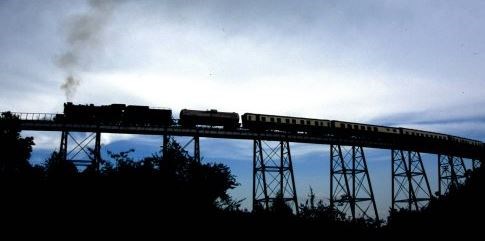
Note: the given coordinates are for the parking area at the museum entrance
The cache is hidden in the sidings at the National Railway Museum in Nairobi, established in 1971 by the then East African Railways and Harbours Corporation to preserve and display relics and records of the railways of East Africa from their inception to the present day. As well as a collection of a dozen steam and diesel locomotives and rolling stock quietly rusting away in the adjacent sidings, there is a fascinating large display of smaller exhibits, photos and models. Museum opening times are 0845-1700 daily, including most Public Holidays. A small admission fee is charged. See here for more information on the museum, the railway and associated books & films and links to some great Kenya steam photo sites.
To find the Cache:
The trail starts inside the one room museum . . .
Step 1: Towards the left rear of the room are some large-scale models of locomotives in display cases. The number of the large Class 90 diesel electric locomotive is 87AA
Step 2: Now move across to the rear right corner where you will see a huge black steam-operated clanger made by Robert Lattowski of Breslau, Poland, which was fitted to German locomotives in Tanga, Tanzania. The number on this is 9B06
Step 3: Time to go outside and enter the locomotive yard opposite the museum. At S01 17.619 E036 49.326 you will find locomotive #2921, Masai of Kenya, a North British Tribal Class 2-8-2 (see here for details). Clamber up into the driver's cab and look up at the large speed gauge. The highest black figure shown on this is C0 mph.
Step 4: Move on from here to S01 17.591 E036 49.337 under the roofed shelter to the 1st class Uganda Railways Coach #12, which was the scene of a horrific and fatal attack! On the far (north) side of this, at about waist-chest height is a small indentifying sticker with a bar code stating Kenya Railways Corporation 116D1
Step 5: Head over to S01 17.593 E036 49.354 where you there is an ex-Burma Beyer-Garratt locomotive #5505 (see here for details and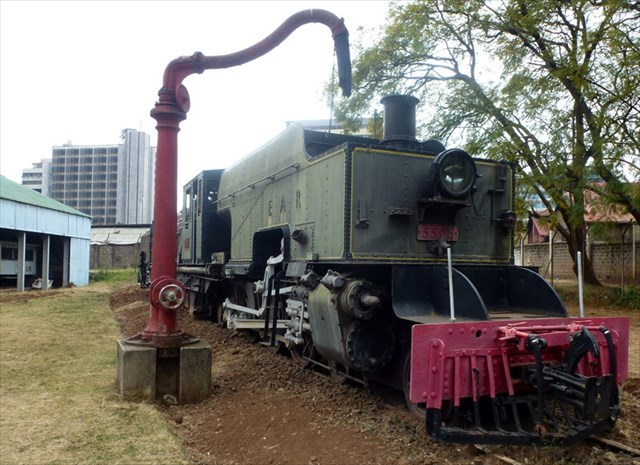 photo) which was withdrawn from Mombasa in 1976. Climb up into the driver's cab and look at the wonderful array of wheels in front of you. There are a total of 8 metal valve adjuster wheels above the large grey metal bar. The number of these with 4 spokes = E
photo) which was withdrawn from Mombasa in 1976. Climb up into the driver's cab and look at the wonderful array of wheels in front of you. There are a total of 8 metal valve adjuster wheels above the large grey metal bar. The number of these with 4 spokes = E
Step 6: In the same cab the number of spokes on the large red wheel to the right of the cab = F
Step 7: Now go across to S01 17.612 E036 49.363 where you will find an old 1st class coach #1129. Climb up and explore inside. The year of manufacture by Metro-Cammell, England is shown on a metal plate at the foot of the entrance as 195G (about upper chest height from ground level before you climb up and in)
Step 8: The number of sleeping berths (ie. upper +lower) in this luxury coach = 1H
Step 9: Now head over to the large red mobile 30-ton steam crane at S01 17.609 E036 49.376. This was made by Ransomes & Rapier of Ipswich, England in 19J6 (the date is shown on a plaque near the centre of the crane and also stamped into the base of the end of the crane).
Step 10 (Cache Location):
The cache, a small magnetic cylindrical container is attached to the large metal object found at:
S01 17.(B+G)(C-E)(D-J) E036 49.(A+D)(F+J)H
Note: Please take care when retrieving and replacing the cache - keep an eye out for muggles and ensure it is carefully replaced as found, ie. in a vertical position so that the magnets grip properly.

The Railway and Steam in East Africa
The Uganda Railway was built by the British government during the Scramble for Africa and was the only genuinely strategic railway to be constructed in tropical Africa at that time. It was 'a truly imperial project' with the purpose of ensuring British domination of the region through its steam-powered access to ferry people and soldiers to Uganda.
It was named after its ultimate destination, but its whole original 660 miles actually lay in what would become Kenya/ Construction began at the British East Africa port city of Mombasa in 1896 and was completed in 1901 at its Kisumu terminus on the eastern shore of Lake Victoria. 2,498 workers died in the harsh working conditions during its construction which faced many challenges in passing through the rugged terrain which included swamps, major ravines & river crossings and of course the huge east and west walls (escarpments) of the Great Rift Valley. Services started in 1903.
All 200,000 individual 30 feet rails, 1.2 million sleepers, 200,000 fish-plates, 400,000 fish-bolts, and 4.8 million steel keys including steel girders for viaducts and causeways had to be imported through Mombasa where a modern port was created at Kilindini. The railway is 1m gauge (deemed 'a foolish mistake' in Parliamentary debate), almost all single-track and cost about £5 million - far more than originally estimated.
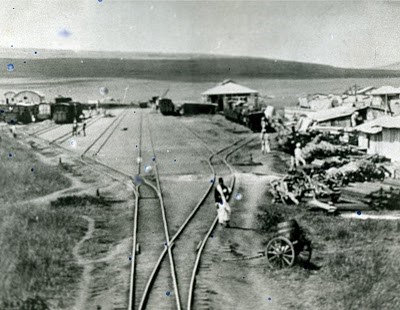 Construction was carried out mainly by 32,000 labourers from British India brought in because of a lack of indigenous labour to exploit. While most of the surviving Indians returned home after the line was completed, 6,724 decided to remain creating a community of Indian East Africans.
Construction was carried out mainly by 32,000 labourers from British India brought in because of a lack of indigenous labour to exploit. While most of the surviving Indians returned home after the line was completed, 6,724 decided to remain creating a community of Indian East Africans.
The railway was a huge logistical achievement and became strategically and economically vital for both Uganda and Kenya. 'It is not uncommon for a country to create a railway but it is uncommon for a railway to create a country' observed Sir Charles Elliot, a senior British Administrator in 1903.
The railway helped suppress slavery, by removing the need for humans in the transport of goods, and helped in the 1st World War campaign against General Paul Erich von Lettow-Vorbeck in German East Africa (now Tanzania) allowing heavy equipment to be transported far inland with relative ease. Before that the main form of transport in the interior was ox-drawn wagon. It also allowed coffee and tea to be exported and encouraged colonial settlement and other types of commerce. In order to help pay for the project, the UK government encouraged white settlers to farm large tracts of Kenyan highlands which the railway had made accessible. This policy would shape the development of Kenya for decades. (The capital city Nairobi started off as a railway workshop built in a swamp!)
The name 'Lunatic Line' was used in contemporary tabloids to describe the view of the railway by Liberal political opponents of the then Conservative government who thought that it was a 'gigantic folly' stating that the Government 'had no right to drive a railway through country owned by the Maasai. And by what right did England have to assert mastery over thousands upon thousands of unlettered African tribesmen?'. One of the leading opponents Henry Labouchere 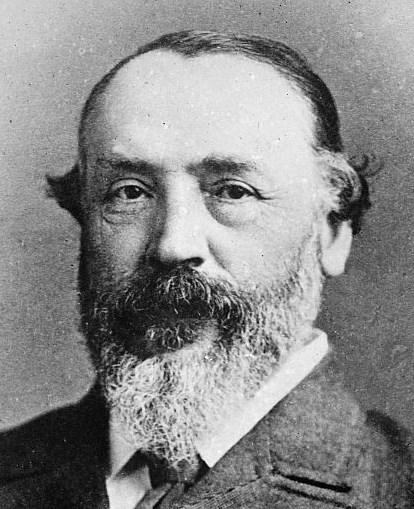 stated in 1896 'the railway starts from nowhere and no one wants to use it. It goes nowhere and no-one wants to come back by it'.
stated in 1896 'the railway starts from nowhere and no one wants to use it. It goes nowhere and no-one wants to come back by it'.
Such arguments along with the claim that it would be a complete waste of taxpayers' money were easily dismissed by the Conservatives who felt all the right reasons were there: the need to ensure protection of the source of the Nile from Britain's enemies, a great potential market for British goods, the huge traffic expected, and a revolutionary effect in settling the region. See here and here for interesting (if lengthy!) verbatim reports of the Parliamentary debates on granting of additional funding for the railway and the Uganda Railway Bill which are full of fascinating historical insights.
The Mighty Garratts
Of the dozen or so locomotives quietly rusting away in the museum rail-yard, the most impressive is the huge #5930 Mount  Shengena Beyer-Garratt Mountain Class 4-8-2+2-8-4. This 251.7 tonne oil-powered beast was the largest and most powerful steam locomotive ever to run on metre gauge tracks - and at one point anywhere in the world. 34 of these locomotives were specially built in UK for East African Railways. They were designed to haul 1,200-ton trains on 1.5% gradients and were the mainstay of freight services on the 330-mile run from Mombasa to Nairobi until the late 1970s. See here for more info on this legendary pinnacle of steam engineering, here for a video of its still functioning sister Mount Gelai on the Mombasa to Nairobi line in 2005 and here for a long and detailed set of fascinating stories, reminiscences and great old photos of Garratt locomotives and school trains in East Africa.
Shengena Beyer-Garratt Mountain Class 4-8-2+2-8-4. This 251.7 tonne oil-powered beast was the largest and most powerful steam locomotive ever to run on metre gauge tracks - and at one point anywhere in the world. 34 of these locomotives were specially built in UK for East African Railways. They were designed to haul 1,200-ton trains on 1.5% gradients and were the mainstay of freight services on the 330-mile run from Mombasa to Nairobi until the late 1970s. See here for more info on this legendary pinnacle of steam engineering, here for a video of its still functioning sister Mount Gelai on the Mombasa to Nairobi line in 2005 and here for a long and detailed set of fascinating stories, reminiscences and great old photos of Garratt locomotives and school trains in East Africa.
The Railway Reborn . . .
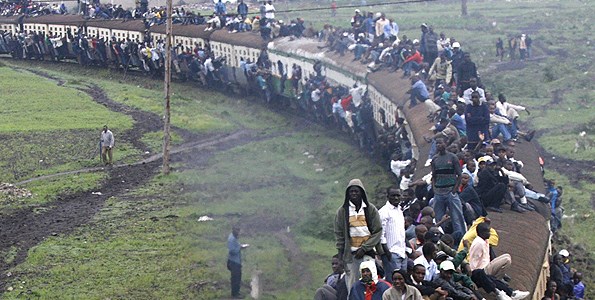 The railway, whose management was taken over by international consortium Rift Valley Railways in November 2006, is now in the process of being resurrected, modernised and rebuilt in standard gauge. Substantial Chinese investment in the project has been secured from the Chinese during an August 2013 state visit by the Kenya President Uhuru Kenyatta.
The railway, whose management was taken over by international consortium Rift Valley Railways in November 2006, is now in the process of being resurrected, modernised and rebuilt in standard gauge. Substantial Chinese investment in the project has been secured from the Chinese during an August 2013 state visit by the Kenya President Uhuru Kenyatta.
Under a Kshs 24 billion (USD 300 million) Kenya Railways Commuter Rail Project a new commuter line from Nairobi heading 10 miles east to new suburban housing estates opened in November 2012 and a further 60 miles of commuter links will be opened in the next 5-7 years with 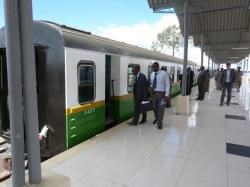 up to 70,000 passengers expected each day. Each of the 9 coach trains will carry 1,600 passengers equivalent to 115 of the overcrowded and polluting minibus taxis that cause daily havoc on Nairobi's roads. Currently 30,000 people use the 18 existing commuter services each work day. Hopefully scenes like that in the photo above will become a thing of the past . . .
up to 70,000 passengers expected each day. Each of the 9 coach trains will carry 1,600 passengers equivalent to 115 of the overcrowded and polluting minibus taxis that cause daily havoc on Nairobi's roads. Currently 30,000 people use the 18 existing commuter services each work day. Hopefully scenes like that in the photo above will become a thing of the past . . .
For more information on this extraordinary railway (including enormous engineering challenges, massacres and man-eaters!) see here which also has details of the numerous books and films on the railway.
See here and here for the story of the Tsavo man-eating lions which caused havoc during the construction of this part of the line.
See here for information on Beyer Peacock and its Garratt locomotives (including the reason why they were so appropriate for use on lighter rails in less developed countrie), here for a list of all the Garratts made and here for details of their dimensions & specifications.
See here for a rich source of photos of East African railways and steam locomotives
See here for a great collection of photos of Kenya steam motive power . . .
there are many other fascinating web pages on East African railways and their steam locomotives!